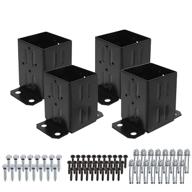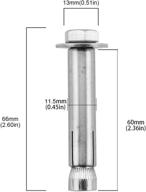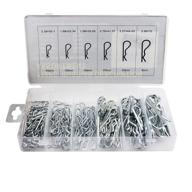What Are Retaining Rings and Where Are They Used?
Retaining rings, also known as snap rings or circlips, are fasteners used to securely hold components in place by fitting into a machined groove on a shaft or inside a bore. They provide a shoulder for parts like gears, bearings, and pistons so they stay located axially on the shaft. Retaining rings are widely used across many industries because they offer reliable and inexpensive part retention.
Types of Retaining Rings
There are two main types of retaining rings:
- External retaining rings fit into a groove on the outside diameter of a shaft.
- Internal retaining rings fit into a groove on the inside diameter of a bore.
Within these two main categories, there are also different styles:
- E-style rings are flat and have ears for installation with pliers.
- C-style rings are curved for self-retention and do not require special pliers.
- Spirolox rings have a spiral design for easy installation.
- Pressure rings exert light axial force to eliminate play.
Common Applications
Some of the most common uses for retaining rings across various industries include:
| Application | Example |
|---|---|
| Securing bearings on shafts | Bearings in electric motors, conveyors, presses |
| Locating components like pistons and gears | Transmission gears, engine pistons |
| Preventing side movement of parts on shafts | Pulleys, sprockets, clutches |
They are ubiquitous in machinery like transmissions, gearboxes, pumps, compressors, appliances, vehicles, aircraft, and more. Any application where a grooved shaft or housing is used, a retaining ring can provide economical part retention.
Benefits of Using Retaining Rings
Some key benefits of using retaining rings include:
- Low cost compared to machining shoulders on shafts
- Quick and easy installation into grooves
- Adaptability - can be moved to change positioning
- Compact axial retention
- Standardized sizing system
- Reusability
With their versatile, economical design and ease of installation, retaining rings are an essential component used in countless mechanical systems and industries worldwide.
Types of Retaining Rings (External, Internal, E-Style, C-Style, etc.)
There are a variety of retaining ring types that serve the purpose of securing parts onto shafts and in housings/bores. The main categories are external and internal rings.
External Retaining Rings
External retaining rings fit into a machined groove on the outer diameter of a shaft. Some common types include:
- E-Style - Flat ring with ears and holes for installing with pliers.
- C-Style - Curved ring that self-retains in the groove.
- Spirolox - Spiral push-on ring for easy installation.
- Pressure Ring - Exerts light axial force to take up play.
Internal Retaining Rings
Internal retaining rings fit into a groove inside a bore or housing to retain items like bearings, gears, etc. Some common internal types include:
- Standard Internal - Most common style, tappered section rings.
- Constant Section Rings - Uniform cross section for heavy load.
- Self-Locking Rings - Grips into housing for non-rotational use.
- Thread-On Rings - Screws into housing threads.
Comparison Between External and Internal
| External | Internal |
|---|---|
| Installed in shaft groove | Installed in housing bore groove |
| Easier to install | More difficult installation |
| Push-on / plier-installed | Pliers or screwdrivers needed |
While external and internal rings have some differences, they both serve the fundamental purpose of retaining parts securely in position on shafts and in bores or housings.
Understanding the various types and styles enables selecting the optimal retaining ring for any application.
How to Choose the Right Retaining Ring for Your Application
Choosing the correct retaining ring for an application requires considering several factors:
1. Internal or External
First decide whether you need an internal or external ring based on where the groove is located.
- External rings fit in a groove on the OD of a shaft.
- Internal rings fit in a bore ID groove.
2. Axial or Radial Load
Determine the load direction. Axial loads push against the ring axially while radial loads are perpendicular.
- Axial loads are more common.
- Heavy radial loads require a larger, thicker ring.
3. Size and Material
Measure the groove diameter and width to determine the required ring size.
- Ring material depends on design load, environmental conditions, cost.
- Common materials: steel, stainless steel, engineered plastics.
4. Housing Style
Select housing based on installation method and retention needs.
- E-rings require pliers to install and remove.
- Self-locking rings don't need pliers but can't rotate.
- Spiral rings are easy to install but only handle light loads.
5. Tolerances
Engineered clearance between ring and groove prevents binding.
- Running clearance is typically .002" for steel rings.
- Increase clearance for coated/plated rings.
Additionally, consider temperature, corrosion, vibration, and any chemicals the rings will be exposed to in the application.
With the right considerations made, retaining rings can be optimally selected for long-lasting, secure functionality in any application.
Installing and Removing Retaining Rings
Properly installing and removing retaining rings is key to their effective use. Here are some tips on best practices:
Installation Tips
- Use proper pliers - ring pliers allow controlled installation.
- Compress ring completely before installing in groove.
- Make sure ring sits fully in groove after installation.
- For self-locking rings, rotate ring as you install to engage locking action.
- Avoid overstretching rings during installation.
- Lubricate rings that require rotating during installation.
- Take care not to damage ring, component, or groove surface.
Removal Tips
- Use proper pliers and technique for ring style.
- Position pliers tips correctly at ends of ring or lugs.
- Squeeze ring ends together to depress one side into groove.
- Rotate compressed ring out of groove channel.
- For stiff rings, use lubricant to aid removal.
- Inspect rings and groove after removal for damage.
External Ring Installation
For external rings:
- Hold compressed ring against chamfered side of groove.
- Roll ring over shaft and into groove by releasing plier pressure.
- Make sure ring is fully seated in groove after installation.
Internal Ring Installation
For internal rings:
- Use pliers to compress ring for insertion into bore.
- Position one plier tip behind ring lug.
- Insert compressed ring past bore and into groove.
- Release pliers to expand and seat ring.
Always follow manufacturer instructions for proper retaining ring installation and removal. Taking care during these procedures will prevent damage and ensure the rings function as designed.
With practice, install and removal can be done quickly and reliably, allowing users to take full advantage of retaining rings' convenience and versatility.
Retaining Ring Materials (Steel, Stainless Steel, Plastic, etc.)
Retaining rings are manufactured from various materials depending on the design requirements of the application.
Carbon Steel
The most common retaining ring material. Advantages:
- Inexpensive
- Readily available
- High strength
- Withstands high temps
Disadvantages:
- Prone to corrosion
- Low corrosion resistance
Best for indoor, non-corrosive environments.
Stainless Steel
Used when corrosion resistance is needed. Benefits:
- High corrosion resistance
- Withstands high temps
- High strength
- Good chemical resistance
Limitations:
- More expensive than carbon steel
- Can still oxidize over time
Engineered Plastics
Used when non-conductive, non-corrosive properties are required:
- Acetal (POM)
- Nylon (PA)
- Peek
- Polyethylene
- Teflon (PTFE)
Benefits:
- Resistant to corrosion and chemicals
- Low conductivity
- Low friction
- Lightweight
Limitations:
- Lower strength than metals
- Not suitable for high heat applications
Selecting the optimal retaining ring material depends on corrosion, temperature, conductivity, friction, and strength needs.
Retaining Ring Sizes - Understanding Dash Numbers
Retaining rings are specified by "dash numbers" that correspond to a sizing system for matching rings to grooved shafts and housings. Understanding this system is key for proper ring selection.
Dash Size Format
Retaining ring dash sizes follow this format:
- The first number indicates the ring's nominal diameter (in inches).
- The second "dash" number specifies ring thickness.
- The third number denotes groove width.
For example, a 1-1/4"-078 ring has a nominal diameter of 1.25", a thickness of .078", and fits a .078" groove width.
Measuring Ring Dimensions
To determine the dash size needed:
- Measure shaft or bore diameter:
- Use calipers to find the outside diameter (OD) for external rings.
- Measure inside diameter (ID) for internal rings.
- Measure groove width using calipers, micrometer, or optical comparator.
- Choose standard ring thickness based on application.
Allowance and Tolerance
Proper clearance allowance is essential:
- Ring ID is always slightly larger than shaft OD.
- Ring OD is minimally smaller than groove ID.
- This prevents binding and provides a snug fit.
Standard tolerance is ±.002" but tighter tolerances are available.
Considerations
- Ring position and orientation
- Radial vs. axial loading
- Environmental conditions
- Material (steel, plastic, etc.)
Understanding the dash size system allows properly matching rings to application specifications. Partnering with a manufacturer can ensure optimal ring selection and fit.
Troubleshooting Common Retaining Ring Problems (Ring Popping Off, Difficulty Installing, etc.)
Retaining rings provide reliable fastening when installed properly, but issues can occur. Here are some common problems and troubleshooting tips:
Ring Keeps Popping Off
- Use calipers to check groove dimensions match the ring dash size.
- Inspect ring and groove for damage or burrs preventing proper seating.
- Ensure ring tolerance provides sufficient grip without binding.
- Consider a thicker ring profile for more grip if the application allows it.
Difficulty Installing Ring
- Make sure pliers are sized for the ring diameter.
- Lubricate the ring and groove to ease installation.
- Don't overcompress the ring which can lead to permanent deformation.
- Verify ring and groove dimensions are compatible.
Ring Broken During Installation
- Use proper pliers designed for ring installation.
- Replace worn plier tips to prevent ring damage.
- Check if ring size allows complete compression by pliers.
- Avoid side-loading rings during installation.
Ring Won't Compress Enough for Installation
- Make sure pliers are suited for the ring size.
- Lubricate rings to reduce friction when compressing.
- Inspect for ring damage preventing full compression.
- Use pliers with smooth, flat contact surfaces.
Ring Rotates in the Groove
- Consider a ring with lug pins, tabs, or self-locking design.
- Check for wear in the groove allowing movement.
- Replace damaged or worn rings allowing play.
Taking the time to properly troubleshoot and address common retaining ring issues will lead to reliable long-term fastening and easier repairs down the road.
What is the benefit of Amazon Prime when buying Retaining Rings?
Amazon Prime provides several benefits when purchasing retaining rings that can save you time and money:
Free Two-Day Shipping
With Prime's free two-day shipping on eligible items, you can get the retaining rings you need quickly. This avoids long wait times compared to standard shipping methods.
Free One-Day Delivery
On qualifying orders over $35, you can get free one-day delivery with Prime. This ensures you get your retaining rings even faster to minimize downtime in operations.
Free Same-Day Delivery
In eligible zip codes, Prime offers free same-day delivery on thousands of items. For time-sensitive applications, you can get retaining rings delivered the same day.
Prime Try Before You Buy
You can try out retaining rings before purchasing them with Prime Try Before You Buy. This allows you to test rings for proper fit and performance before committing.
Prime Savings and Deals
Exclusive Prime-member deals and savings are offered on some retaining ring products. This provides the opportunity to get rings you need at a lower cost.
With fast, free shipping and other benefits, Amazon Prime is a valuable tool for conveniently and affordably getting retaining ring orders delivered when you need them.
What Are The Different Types Of Retaining Rings Available In The Market??
There are several types of retaining rings available in the market. Here are the main types of retaining rings:
Tapered section retaining rings can be axially or radially assembled and can be further broken down into sub-types such as inverted, beveled, and bowed. Constant section retaining rings are also known as snap rings and are used for light to medium-duty applications. Spiral retaining rings are used for heavy-duty applications and can be used in both axial and radial directions. Circular push-on retaining rings can be installed in applications where there is no groove. Hoopster retaining rings are used for low clearance applications and WaveRing retaining rings are used for high thrust load applications.
Another interesting products
What Are The Differences Between Tapered Section And Constant Section Retaining Rings??
Tapered section and constant section retaining rings are two different types of retaining rings. Here are the main differences between them:
Tapered section retaining rings:
Constant section retaining rings:
Overall, the main difference between tapered section and constant section retaining rings is their design and intended use. Tapered section retaining rings are designed for heavy-duty applications and high thrust loads, while constant section retaining rings are designed for light to medium-duty applications and offer greater clearance.
What Are The Advantages Of Using Tapered Section Retaining Rings Over Constant Section Retaining Rings??
Advantages of using tapered section retaining rings over constant section retaining rings include:
Overall, tapered section retaining rings are a cost-effective option for high-speed applications that require low balance/noise in the assembly. They are designed for high thrust loads and heavy-duty applications and are used in thousands of applications across industries such as automotive, aerospace, and medical.














